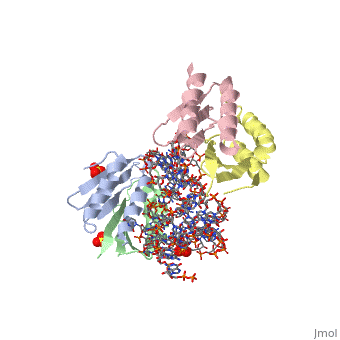Signal recognition particle protein: Difference between revisions
Michal Harel (talk | contribs) No edit summary |
Michal Harel (talk | contribs) No edit summary |
||
| (11 intermediate revisions by the same user not shown) | |||
| Line 1: | Line 1: | ||
<StructureSection load='1e8o' size='350' side='right' scene='' caption='Human SRP9 (grey and pink) +SRP14 (green and yellow) complex with 7S RNA, GDP and sulfate [[1e8o]]'> | |||
'''Signal recognition particle''' (SRP) is a ribonucleoprotein which targets specific proteins to the endoplasmic reticulum (ER) in eukaryotes and the plasma membrane in prokaryotes. In eukaryotes SRP binds to the signal sequence of a newly synthesized polypeptide as it emerges from the ribosome. The binding allows for the coupling of the translation process to the translocation process. The SRP targets the nascent protein to the ER by docking into the [[Signal recognition particle receptor|SRP receptor]]<ref>PMID:15718142</ref>. The eukaryotic SRP which has GTPase activity, is composed of SRP9, SRP14<ref>PMID:7542942</ref>, SRP19<ref>PMID:11682607</ref>, SRP54<ref>PMID:9511762</ref>, SRP68, SRP72<ref>PMID:8388879</ref> and 7S RNA. The prokaryotic SRP is composed of FFH (SRP54-like) and 4.5S RNA. | |||
'''Signal recognition particle''' (SRP) is a ribonucleoprotein which targets specific proteins to the endoplasmic reticulum (ER) in eukaryotes and the plasma membrane in prokaryotes. In eukaryotes SRP binds to the signal sequence of a newly synthesized polypeptide as it emerges from the ribosome. The binding allows for the coupling of the translation process to the translocation process. The SRP targets the nascent protein to the ER by docking into the [[Signal recognition particle receptor|SRP receptor]]. The eukaryotic SRP which has GTPase activity, is composed of SRP9, SRP14 | |||
==3D structures of signal recognition particle== | |||
[[Signal recognition particle 3D structures]] | |||
== References == | |||
<references/> | |||
</StructureSection> | |||
[[Category:Topic Page]] | [[Category:Topic Page]] | ||
Latest revision as of 13:19, 20 November 2023
Signal recognition particle (SRP) is a ribonucleoprotein which targets specific proteins to the endoplasmic reticulum (ER) in eukaryotes and the plasma membrane in prokaryotes. In eukaryotes SRP binds to the signal sequence of a newly synthesized polypeptide as it emerges from the ribosome. The binding allows for the coupling of the translation process to the translocation process. The SRP targets the nascent protein to the ER by docking into the SRP receptor[1]. The eukaryotic SRP which has GTPase activity, is composed of SRP9, SRP14[2], SRP19[3], SRP54[4], SRP68, SRP72[5] and 7S RNA. The prokaryotic SRP is composed of FFH (SRP54-like) and 4.5S RNA. 3D structures of signal recognition particleSignal recognition particle 3D structures References
|
| ||||||||||
